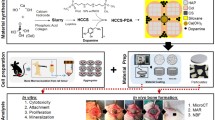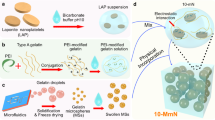Abstract
Human mesenchymal stem cells (hMSCs) typically range in size from 10 to 50 μm and proteins that mediate hMSC adhesion and differentiation usually have a size of a few nanometers. Nanomaterials with a feature size smaller than 100 nm have demonstrated the unique capability of promoting osteoblast (bone forming cell) adhesion and long-term functions, leading to more effective bone tissue regeneration. For new bone deposition, MSCs have to be recruited to the injury or disease sites and then differentiate into osteoblasts. Therefore, designing novel nanomaterials that are capable of attracting MSCs and directing their differentiation is of great interest to many clinical applications. This in vitro study investigated the effects of nanophase hydroxyapatite (nano-HA), nano-HA/poly(lactide-co-glycolide) (PLGA) composites and a bone morphogenetic protein (BMP-7) derived short peptide on osteogenic differentiation of hMSCs. The short peptide was loaded by physical adsorption to nano-HA or by dispersion in nanocomposites and in PLGA to determine their effects on hMSC adhesion and differentiation. The results showed that the nano-HA/PLGA composites promoted hMSC adhesion as compared to the PLGA controls. Moreover, nano-HA/PLGA composites promoted osteogenic differentiation of hMSCs to a similar extent with or without the presence of osteogenic factors in the media. In the MSC growth media without the osteogenic factors, the nanocomposites supported greater calcium-containing bone mineral deposition by hMSC than the BMP-derived short peptide alone. The nanocomposites provided promising alternatives in controlling the adhesion and differentiation of hMSCs without osteogenic factors from the culture media, and, thus, should be further studied for clinical translation and the development of novel nanocomposite-guided stem cell therapies.





Similar content being viewed by others
References
Liu H, Slamovich EB, Webster TJ. Increased osteoblast functions among nanophase titania/poly(lactide-co-glycolide) composites of the highest nanometer surface roughness. J Biomed Mater Res A. 2006;78(4):798–807.
Liu H, Yazici H, Ergun C, Webster TJ, Bermek H. An in vitro evaluation of the Ca/P ratio for the cytocompatibility of nano-to-micron particulate calcium phosphates for bone regeneration. Acta Biomater. 2008;4(5):1472–9.
Ergun C, Liu H, Halloran JW, Webster TJ. Increased osteoblast adhesion on nanograined hydroxyapatite and tricalcium phosphate containing calcium titanate. J Biomed Mater Res A. 2007;80(4):990–7.
Liu H, Webster TJ. Mechanical properties of dispersed ceramic nanoparticles in polymer composites for orthopedic applications. Int J Nanomed. 2010;5:299–313.
Liu H, Webster TJ. Nanomedicine for implants: a review of studies and necessary experimental tools. Biomaterials. 2006;28(2):354–69.
Wang EA, Rosen V, D’Alessandro JS, Bauduy M, Cordes P, Harada T, Israel DI, Hewick RM, Kerns KM, LaPan P, et al. Recombinant human bone morphogenetic protein induces bone formation. Proc Natl Acad Sci USA. 1990;87(6):2220–4.
Wozney JM, Rosen V, Celeste AJ, Mitsock LM, Whitters MJ, Kriz RW, Hewick RM, Wang EA. Novel regulators of bone formation: molecular clones and activities. Science. 1988;242(4885):1528–34.
Glassman SD, Carreon LY, Campbell MJ, Johnson JR, Puno RM, Djurasovic M, Dimar JR. The perioperative cost of infuse bone graft in posterolateral lumbar spine fusion. Spine J. 2008;8(3):443–8.
Smoljanovic T, Bicanic G, Bojanic I. Update of comprehensive review of the safety profile of bone morphogenetic protein in spine surgery. Neurosurgery. 2010;66(5):E1030. author reply E1030.
Benglis D, Wang MY, Levi AD. A comprehensive review of the safety profile of bone morphogenetic protein in spine surgery. Neurosurgery 2008;62(5 Suppl 2):ONS423-31; discussion ONS431.
Haid RW, Jr, Branch CL, Jr, Alexander JT, Burkus JK. Posterior lumbar interbody fusion using recombinant human bone morphogenetic protein type 2 with cylindrical interbody cages. Spine J. 2004;4(5):527–38. discussion 538-9.
McKay WF, Peckham SM, Badura JM. A comprehensive clinical review of recombinant human bone morphogenetic protein-2 (INFUSE (R) Bone Graft). Int Orthop. 2007;31(6):729–34.
Chen Y, Webster TJ. Increased osteoblast functions in the presence of BMP-7 short peptides for nanostructured biomaterial applications. J Biomed Mater Res A. 2009;91(1):296–304.
Liu H, Webster TJ. Ceramic/polymer nanocomposites with tunable drug delivery capability at specific disease sites. J Biomed Mater Res A. 2010;93(3):1180–92.
Lock J, Liu H. Nanomaterials enhance osteogenic differentiation of human mesenchymal stem cells similar to a short peptide of BMP-7. Int J Nanomed. 2011;6:2769–77.
Sato M, Sambito MA, Aslani A, Kalkhoran NM, Slamovich EB, Webster TJ. Increased osteoblast functions on undoped and yttrium-doped nanocrystalline hydroxyapatite coatings on titanium. Biomaterials. 2006;27(11):2358–69.
Ioku K, Yoshimura M. Stoichiometric apatite fine single crystals by hydrothermal synthesis. Phosphorus Res Bull. 1991;1:15–20.
Somiya S, Ioku K, Yoshimura M. Hydrothermal synthesis and characterization of fine apatite crystals. Magnes Sci Technol Appl. 1988;34:371–8.
Hing KA, Revell PA, Smith N, Buckland T. Effect of silicon level on rate, quality and progression of bone healing within silicate-substituted porous hydroxyapatite scaffolds. Biomaterials. 2006;27(29):5014–26.
Coathup M, Smith N, Kingsley C, Buckland T, Dattani R, Ascroft P, Blumn G. Impaction grafting with a bone-graft substitute in a sheep model of revision hip replacement. J Bone Joint Surg Br. 2008;90B(2):246–53.
Siffert RS. The role of alkaline phosphatase in osteogenesis. J Exp Med. 1951;93(5):415–29.
Sato M, Aslani A, Sambito MA, Kalkhoran NM, Slamovich EB, Webster TJ. Nanocrystalline hydroxyapatite/titania coatings on titanium improves osteoblast adhesion. J Biomed Mater Res A. 2008;84(1):265–72.
Balasundaram G, Sato M, Webster TJ. Using hydroxyapatite nanoparticles and decreased crystallinity to promote osteoblast adhesion similar to functionalizing with RGD. Biomaterials. 2006;27(14):2798–805.
Zhang R, Ma PX. Degradation behavior of porous poly(a-hydroxy acids)/hydroxyapatite composite scaffolds. American Chemical Society. 2000;41(2):1618–19.
Noohom W, Jack KS, Martin D, Trau M. Understanding the roles of nanoparticle dispersion and polymer crystallinity in controlling the mechanical properties of HA/PHBV nanocomposites. Biomed Mater. 2009;4(1):015003.
Palin E, Liu HN, Webster TJ. Mimicking the nanofeatures of bone increases bone-forming cell adhesion and proliferation. Nanotechnology. 2005;16(9):1828–35.
Liu HN, Slamovich EB, Webster TJ. Increased osteoblast functions on nanophase titania dispersed in poly-lactic-co-glycolic acid composites. Nanotechnology. 2005;16(7):S601–8.
Senta H, Bergeron E, Drevelle O, Park H, Faucheux N. Combination of synthetic peptides derived from bone morphogenetic proteins and biomaterials for medical applications. Can J Chem Eng. 2011;89(2):227–39.
Acknowledgments
The author would like to thank the NSF BRIGE award (CBET 1125801), Burroughs Wellcome Fund (1011235), and the University of California for financial support.
Author information
Authors and Affiliations
Corresponding author
Rights and permissions
About this article
Cite this article
Lock, J., Nguyen, T.Y. & Liu, H. Nanophase hydroxyapatite and poly(lactide-co-glycolide) composites promote human mesenchymal stem cell adhesion and osteogenic differentiation in vitro. J Mater Sci: Mater Med 23, 2543–2552 (2012). https://doi.org/10.1007/s10856-012-4709-0
Received:
Accepted:
Published:
Issue Date:
DOI: https://doi.org/10.1007/s10856-012-4709-0




